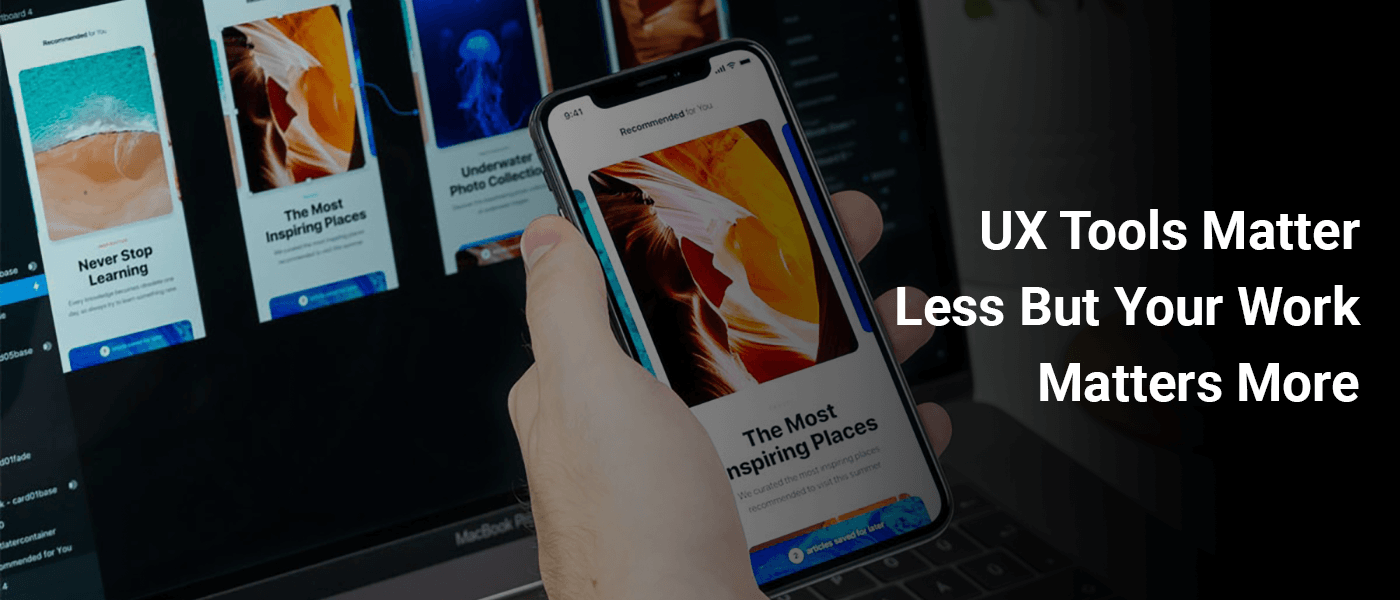The love of tools for any UX designer is inexplicable. With several releases of new tools every year, you must not slip your hold to the latest or shiniest. It is a matter of fact to notice that though they carry a role in the design process, they are not the most essential thing to worry about.
Don’t take us wrong because we mean that they are neither bad nor that you should not learn UX tools. But, we are only asking you to tune out the buzz and follow the appropriate mindset to bring its proper use into play.
So, we are listing out a good set of reasons for you to hear the right signal and drive your focus to what is needed.
- Your work matters more than the tool you choose:
A UX designer must decide his/her aim than to choose the tool to use. When you aspire for a UX position, it is not about the usage of different kinds of tools that determines your hiring but the knowledge that you possess and the way you think. In simpler words, UX design is everything about the design knowledge that you possess and how you carry it out to bring useful and great results.
Let us illustrate the scenario for your better understanding. Let’s assume that you build a signup screen for a mobile application. For a commendable job, you need to consider what goes where. Where do you want to want to put the name and e-mail fields? Is there a need for a password field? Think about the number of steps that the signup flow should comprise of. Learn about all the necessary steps that gear up your beginning.
And, if you tend to focus on which tool you are likely to use then, you will miss the bigger picture. In this case, you will probably end up creating something trendy but fail to meet the work your users aim to do.
Thus, it is vital to start with essential UX considerations. Otherwise, you will land up in a stage of a failed solution irrespective of the tool you use. On the contrary, if you begin with something that helps you reach your goal, you will be able to create exceptionally good solutions just with the help of a paper and pencil.
- Tools keep changing all the time:
Tools change rapidly. For example- the popular tool ‘SKETCH’ gets updated every month like various other UX tools. Third-party tools and new add-ons are being launched almost every time.
This implies that if your goal is only on the tools, your vision will turn short-sighted. You need to have sight beyond the release of the shiniest tools to stand on a concrete ground as a UX designer. Otherwise, you will end up chasing the new updates constantly and the features will soon overwhelm you. And, you will slip past the hold of UX principles that will affect your design sooner than later.
You will fail to stand out if you keep running behind the tools. But, you can win if your eye is on the timeless design principles. However, the next decade will use drastically conflicting tools. So, it is always about following the design principles and the psychological approach that you learn as they never divert with time. Aim for the latter and you can enjoy a long-term advantage that is laced with future-proof benefits too.
- Different companies employ different tools:
Imagine that you focused on several UX tools as per your wish and the company that hires you, uses a completely different set of tools. Adobe XD might be used by a company for creating high-fidelity prototypes and InVision for incorporating animations and interactions with the exported designs. Meanwhile, other companies might use Balsamiq for sketching and meeting the prototype purpose, then Zeplin to hand off the designs to developers.
And after the long run of 5 years, they will probably be using a different set of tools.
In simple words, you can adapt and learn about the different tools that matter the most than that of using a particular tool. You should walk past the idea of a single best tool for a designer and accept that the tools can be interchanged or replaced anytime.
If ever you become a part of any new company or your existing company shifts its focus, you will realize to learn about the tools that could support your creation.
- UX recruiters and experts think the same:
You can follow the quotes of the UX experts themselves if you need more convincing. With 35 years of experience in UX and leading the two top software companies of the world for about more than 18 years like Oracle and SAP, Dan Rosenburg says that the wireframes, prototypes, and journey maps produced by a UX designer matters much more than the tool they used to create it.
Another statement comes from Tanner Christensen who is a product designer at Lyft says that he never met a designer who was hired for the tool they use.
- It’s you who make the designs not tools:
“UX tools are not a prized possession that can outshine your portfolio.” I hope that by now you are convinced by the above statement. It is your brain that will help you pave the way to becoming an extraordinary UX designer. Believe in this insight and focus on timeless design principles to use them in your design decisions. Be the artist and carefully use the UX tools that are intended to go with your designs.




